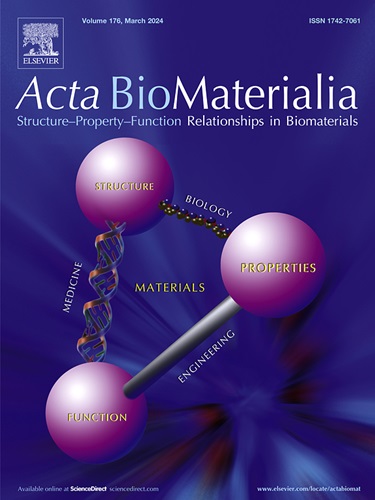新鲜病变人食道的离体力学结构特征。
IF 9.4
1区 医学
Q1 ENGINEERING, BIOMEDICAL
引用次数: 0
摘要
食道是将食物从咽输送到胃的管状器官,它是高度机械的,具有根据神经冲动收缩和扩张的能力。尽管力学在这个器官中起着核心作用,并且需要高保真的食管运输模型,但人类食管的力学表征研究相对较少。再加上对人类标本的研究缺乏,现有的结果在方法和范围方面往往是分散的,这使得很难比较不同研究的结果,从而阻碍了它们在计算模型中的潜在应用。在这项工作中,我们提出了一个详细的被动力学和结构特征的食管肌肉层,切除短食管段从不同临床表现的活的病人。特别是,我们在平滑肌层进行单轴和平面双轴拉伸测试,并通过组织学成像进行测试前和测试后的结构表征。与现有研究相比,本文讨论了被动行为的实验结果,并将其置于生理相关性(即生理拉伸、活动抑制病理)的背景下,指导后续食管机械反应的建模。因此,这项工作提供了对新鲜人食管被动特性的新见解,有助于现有的可用于计算建模的力学参数数据库,并为未来涉及主动力学特性的表征奠定了基础。意义声明:了解食道的力学特性对于建立其功能的精确模型和合适的替代品至关重要。这项研究提供了对新鲜人食管组织被动力学行为的见解,增强了我们对它在生理条件下对拉伸的反应的理解。通过表征不同表现的食管切除术标本中不同食道层的特性,并考虑其与正常和异常功能的相关性,这项工作有助于填补离体人食管研究的空白。这些发现强调了在生理参数范围内对实验结果进行背景分析的重要性,并为进一步完善我们对食管力学的理解提供了未来研究的途径,为改善食管疾病的诊断和治疗方法铺平了道路。本文章由计算机程序翻译,如有差异,请以英文原文为准。

Ex-vivo mechano-structural characterization of fresh diseased human esophagus
The esophagus, the tube-like organ responsible for transporting food from the pharynx to the stomach, operates as a highly mechanical structure, exhibiting complex contraction and distension patterns triggered by neurological impulses. Despite the critical role of mechanics in its function and the need for high-fidelity models of esophageal transport, mechanical characterization studies of human esophagus remain relatively scarce. In addition to the paucity of studies in human specimens, the available results are often scattered in terms of methodology and scope, making it difficult to compare findings across studies and thereby limiting their use in computational models. In this work, we present a detailed passive-mechanical and structural characterization of the esophageal muscular layers, excised from short esophageal segments obtained from live patients with varied clinical presentations. Specifically, we conducted uniaxial and planar biaxial extension tests on the smooth muscle layers, complemented by pre- and post-testing structural characterization via histological imaging. Unlike existing studies, our experimental results on passive behavior are discussed in the context of physiological relevance (e.g., physiological stretches, and activity-inhibiting pathologies), providing valuable insights that guide the subsequent modeling of the esophagus’ mechanical response. As such, this work provides new insights into the passive properties of the fresh human esophagus, expands the existing database of mechanical parameters for computational modeling, and lays the foundation for future studies on active mechanical properties.
Statement of significance
Understanding the mechanical properties of the esophagus is crucial for developing accurate models of its function and suitable replacements. This study provides insights into the passive mechanical behavior of fresh human esophageal tissue, enhancing our understanding of how it responds to stretching under physiological conditions. By characterizing the properties of different esophageal layers, obtained from esophagectomy specimens with various presentations, and considering their relevance to both normal and abnormal functioning, this work addresses the gap in ex-vivo human esophagus studies. The findings emphasize the importance of contextually analyzing experimental results within physiological parameters and suggest avenues for future research to further refine our understanding of esophageal mechanics, paving the way for improved diagnostic and therapeutic approaches in managing esophageal disorders.
求助全文
通过发布文献求助,成功后即可免费获取论文全文。
去求助
来源期刊

Acta Biomaterialia
工程技术-材料科学:生物材料
CiteScore
16.80
自引率
3.10%
发文量
776
审稿时长
30 days
期刊介绍:
Acta Biomaterialia is a monthly peer-reviewed scientific journal published by Elsevier. The journal was established in January 2005. The editor-in-chief is W.R. Wagner (University of Pittsburgh). The journal covers research in biomaterials science, including the interrelationship of biomaterial structure and function from macroscale to nanoscale. Topical coverage includes biomedical and biocompatible materials.
 求助内容:
求助内容: 应助结果提醒方式:
应助结果提醒方式:


